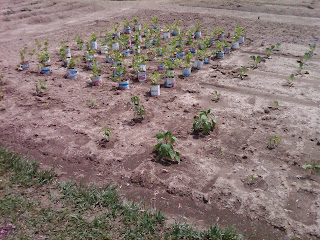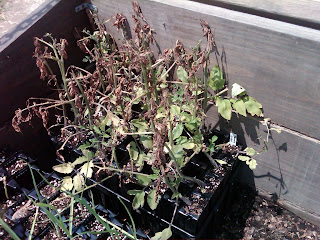In my previous post "Strawberries and Leaf Spot", dated April 14, 2012 I talked about how the disease Leaf Spot was over running my strawberry patch. I talked about how when I first uncovered the strawberries early in spring from their winter protection, they looked wonderful. Then a month later it was obvious that they had some sort of disease, and how through research on the Internet, I identified that disease as Leaf Spot. It started at one end of my patch, and worked it's way across my patch until the entire patch was showing severe infection. Below is what it looks like.
I immediately implemented a regiment of treating the entire patch with the chemical fungicide Capton. It is a wettable powder that I mixed with water and applied with my hand pump sprayer. I applied this every 5-7 days as the weather allowed. Some things to note about application;
So after a month of treatment, i.e. 6 applications, this is the result;
So lessons learned;
 |
| April 14th |
 |
| Not Good |
- Do not apply if rain is forecast within 24 hours. It works best when full or part sunshine is forecast
- The most important thing to remember about application is that the disease comes from the ground, the garden dirt. As it rains the dirt is splashed up onto the plants and the fungus is in the dirt. Therefore it is essential to make sure you thourghly spray the underside of the plants as well as the tops. I spend more of my time spraying the underside of the plants than I do spraying the tops. Spraying the tops is easy, getting the underside takes a lot more care and time.
So after a month of treatment, i.e. 6 applications, this is the result;
 |
| All new growth, disease free |
 |
| Capton works |
 |
| This is the end that the Leaf Spot infected last, it moved from the opposite end down into this end. These plants are still recovering |
So lessons learned;
- Start a fungicide regiment as soon as your strawberry plants are uncovered in the spring and continue until they go dormant in the fall
- Do this even if there is no sign of disease. Less frequently if no sign of disease, more frequently if there is symptoms
5-28-2013
This is a new post...
To follow up, spring of 2012 I had a major infestation of Mycosphaerella fragariae otherwise known as Strawberry "Leaf Spot". Don't know why. What I can tell you is that Capton solved it. After two applications, my plants looked 100% better. After four, leaf spot was gone. Replaced by new wonderful looking growth. Without leaf spot.
Now this year, I experienced NO leaf spot in my strawberry patch. Don't know why. What I can tell you is I did not cover my strawberries last winter. The winter before I did what they recommend, I covered my entire patch, late fall with four inches of straw for winter protection. This past winter I did not do that, I was simply too tired at the end of last year. I hoped I would not lose my entire patch because of laziness.
I found that the plants stayed green all the way through the worst of the winter. Through the cold, wind and under snow. Early January they began to turn brown. By early February all the leaves were brown. I thought the worst. I thought I lost my patch. But by March, they began to produce new growth, new bright green leaves. I was elated. By the middle of April, my patch was back, lush green and strong. I looked closely, I looked with determination, and I could find no indication of leaf spot.
So I sprayed the entire patch with Captan anyway, except for one row. A week later I sprayed it again, except that last row. Again all I can tell you is this year, I have had no indication of, nor been bothered by Mycosphaerella fragariae otherwise known as leaf spot. Including the last row.
I don't know why, but I don't think I will cover my strawberry patch this coming winter.







